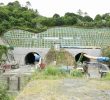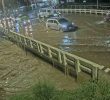The series of violent incidents in Diwalwal last October – a huge fire, a gas poisoning, and a cave-in – could be part of the plot by vested-interest groups to drive small-scale miners out of Mount Diwalwal.
By Daisy C. Gonzales
davaotoday.com
DIWALWAL, the Philippines — Alma Placio, 33, looked exhausted. She just had a baby. Six days after the child was born, Alma lost her husband. On this day, she was at the mining company’s small office here, sitting in a corner.
Evidently grief-stricken, Alma sits calmly as she stared blankly at the television in front of her. The TV was showing images taken days before of a rescue operation inside one of the mining tunnels here, where several died. One of those who perished was Alma’s husband, Al.
Alma was new to this place, so was Al. The lure of Mount Diwalwal, however, was no stranger to them. Earlier this year, they left their home in Manila, where they had stayed for almost two decades, and found their way into this mountain village. Al’s brother had worked here and had convinced Al that he, like him, could work here as a “helper.”
Al went to Diwalwal ahead of his family. In June, Alma and her two children reunited with him. Little did Alma know that the reunion would be short-lived.
Alma’s husband was among the 31 declared to have died in the October 26 tragedy inside the mine tunnel operated by the JB Management and Mining Corp (JBMMC). The cave-in, which was said to be precipitated by an explosion, is the latest reminder here that the main issues about this contested gold-rush mountain village in Monkayo town, in Southern Mindanao, are far from resolved.
Alma’s grief was shared by the others in the same predicament in two other incidents within two weeks last October in the mountains of this hotly contested gold-rush site. In one incident, a day after the Oct. 26 Sunshine tunnel tragedy, poison gas seeped through the Licayan tunnel above, killing a miner and nearly poisoning 11 mine workers.
Days before, on Oct. 14, fire engulfed a populated area, burning down the houses of 189 families and killing a nine-year-old child. The local fire department said the cause was faulty electrical wiring but residents told a recent fact-finding and relief mission that the fire had been a case of arson.
These incidents in October, said the party-list group Bayan Muna and environment alliance Panalipdan, who organized the mission in November, “could be interrelated and not accidental.”
JBMMC, one of the few big mining companies operating here, had said that the Oct. 26 cave-in was an accident. JBMMC’s Sunshine tunnel has been closed down, along with all “illegal mining operations” here. President Gloria Macapagal-Arroyo had issued the closure order while the environment secretary, Michael Defensor, blamed “illegal mining operations” for the tragedy.
The closure of mining tunnels, however, creates serious implications to thousands of mine workers and abanteros – those who do the actual mining of the tunnels — whose scant livelihood depended on the mine sites, according to Diwalwal barangay leader Franco Tito.
“I don’t give a damn about the owners, because they are already millionaires. But what about the abanteros and the workers?” Tito said in an interview.
The closure order, according to the fact-finding mission, “does not resolve” the series of events that happened in Diwalwal last October. The closure order, the mission said in a six-page mission statement, only “bolstered all along what many feared as the Arroyo administration’s scheme to gradually dislocate small-scale miners in the area.”
The solution, said Tito, is for government to support the endeavors of the Diwalwal miners and workers — from the environment to safety and tools. The government must also resolve who should mine the gold rush site, he said.
Government took over control of Diwalwal three years ago, and declared it part of the 8,100-hectare mineral reservation area. Two primary agencies had been put up, the National Resource Development Corporation (NRDC) for tax collection, and the National Resource Mining Development Corporation (NRMDC), which actually does the mining and controls the gold-rush site.
Under the government’s Diwalwal Direct Estate Development Project, the existing mining operators became “service contractors.” They have paid 15 percent of their produce, called run-of-the-mine ore, to government as taxation. The government, said Tito, has collected 44 million pesos in the past two years, but has yet to give the local government their share based on the agreement. The government has yet to build the 50 million pesos tailings dam it promised years ago. “The government reneged on its part,” Tito said.
The NRMDC, meanwhile, had planned a joint venture agreement or a buyout of the existing mining companies. It has already bought the strategic and controversial JBMMC’s Victory tunnel for 80 million pesos, which was originally priced at 300 million pesos.
JBMMC’s Reynaldo Espanola vice president for administration said the government has so far only paid the company about 25 million pesos. The Victory Tunnel is located way below and cuts across almost all the mining tunnels in the gold-rich bowels of Diwalwal. The military is heavily guarding the said mining tunnel and the same contingent patrols day in day out around Diwalwal. It has also established encampments in the middle of populated areas in Diwalwal.










